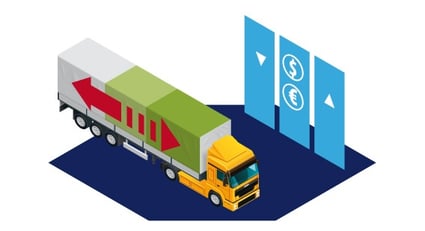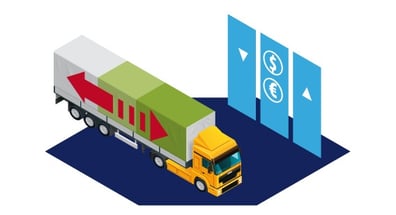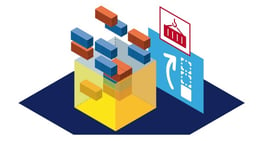5 Ways the IoT Will Impact Logistics in 2021
Jesse Kelber - July 04, 2019

 Industry 4.0 is making waves in the manufacturing and supply chain sectors. But what about logistics? How are these same technological advances helping move those products faster and more efficiently? The goal remains unchanged: to use connected workflows and technologies to give people the tools and freedom they need to adapt and pivot with the changing environment and to seek creative solutions to increasingly complex problems. Logistics 4.0 is here, and one of the primary drivers of this revolution is the Internet of Things (IoT). IoT refers to devices of all sorts, be they tablet computers, sensors monitoring machinery or vehicles, or even wearables that track biometrics to ensure the health and well-being of the workforce, that are all connected to the network.
Industry 4.0 is making waves in the manufacturing and supply chain sectors. But what about logistics? How are these same technological advances helping move those products faster and more efficiently? The goal remains unchanged: to use connected workflows and technologies to give people the tools and freedom they need to adapt and pivot with the changing environment and to seek creative solutions to increasingly complex problems. Logistics 4.0 is here, and one of the primary drivers of this revolution is the Internet of Things (IoT). IoT refers to devices of all sorts, be they tablet computers, sensors monitoring machinery or vehicles, or even wearables that track biometrics to ensure the health and well-being of the workforce, that are all connected to the network.
In industrial settings, these devices are often referred to as the Industrial Internet of Things (IIoT), and these terms are often used interchangeably. The difference, for our purposes, is trivial as the devices are usually the same, all that changes is the equipment being monitored. IoT devices can be used to monitor the health of manufacturing equipment, fleets of trucks, supply levels at both ends of the supply chain, and even the people responsible for making it all work together seamlessly. The IoT stands to make an enormous impact on the end-to-end value chain in the logistics sector in myriad ways. Presented here are our picks for the top 5 ways the Internet of Things will impact logistics in the coming years.
#1: IoT at the warehouse
Real-time stock level monitoring enables planners to know exactly what’s on hand and precisely where it is in the warehouse. Add to that the advanced analytics operating behind the software that can plan out the most efficient route for the forklifts to take while collecting an order for shipping, plus the tracking information coming in from the trucks en route to pick up the order, and it’s possible to significantly cut the necessary time the trucks spend sitting idle at the loading docks. This level of connectivity also means that should disaster strike and there’s a disruption in the supply chain, the planner can work around the issue, finding the needed supplies at a different warehouse and redirecting the trucks there for pick up, for example.
#2: IoT enabled trucks
Connected sensors report on everything from conditions inside the container to remaining fuel levels and how long it’s been since the tires were replaced. Required container conditions can vary widely by the product being transported, and having sensors reporting back to a central location allows for remote monitoring to ensure whatever is inside is delivered in peak condition. Wear and tear on trucks is a huge and variable expense for trucking companies; the ability to perform predictive maintenance based on the data collected from these IoT sensors allows unexpected downtime to be drastically reduced. You no longer have to rely on gut feelings or standing maintenance schedules, instead you can maximize uptime by pinpointing the best time to sideline a truck, while at the same time minimizing the impact on the rest of the fleet. And real-time location monitoring, combined with predictive analysis performed by AI, means routes can be adjusted automatically and trucks rerouted according to weather patterns, fuel costs, or other potential disruptions.
#3: Fuel/transportation costs
Speaking of fuel costs: the combination of GPS- and RFID-enabled IoT devices means that fuel consumption can be closely monitored and costs gauged to allow shipping to avoid areas of higher costs and reroute deliveries through areas with lower transportation costs. This extends from the simple level of routing trucks to stops with lower diesel prices, all the way to transferring the shipment from trucks to rail to further cut transportation costs by sharing the expense with other shipments. The ability of this technology to enable real-time decisions on multi-modal transport options, based on factors like diesel costs in different regions is one of the game-changing aspects of Logistics 4.0. Whereas before, transportation costs were predicated on factors outside of anyone’s immediate control, with this data availability and the real-time nature of IoT sensors, the power is firmly in your hands.
#4: Data integration
Perhaps the greatest impact on the end-to-end supply chain that IoT devices will provide is greater data integration. Visibility is a major sticking point for logistics especially, as the ability to know the exact status of a pickup is crucial for planners attempting to accurately provide a delivery time (for example). Beyond that, the interoperability of IoT-enabled devices with other business systems will provide the ultimate in end-to-end transparency, from parts and supplies, through production, and all the way to final delivery. What will this look like? Using IoT-enabled scanners, sensors, and transmitters, a factory could automatically alert the purchasing department when supplies of a certain part are running low. That information can then be sent to the supplier, automatically, such that a resupply shipment can be arranged. Then, data from IoT-enabled trucks will alert the supplier of their imminent arrival, cutting idle time and moving the shipment along. And, finally, the same data from the supply chain will ensure the factory is alerted to the arrival of these supplies so production won’t take a hit. This process ensures the entire value chain keeps moving smoothly in the right direction.
#5: Data quantities
We’ve already touched on the ability for technicians to schedule predictive maintenance based on IoT sensor data from production machinery or trucks, etc. But there’s so much more the data from these devices can enable. The sheer quantity of data that can be collected, parsed, and reported on by IoT devices is as vast as your imagination. Want a detailed breakdown of the throughput time of the last 4 orders to 3 particular clients? Done. How about the predictive maintenance mentioned above? Now your techs can schedule downtime when the machinery is already idle, eliminating disruptions to shipping schedules. Afraid an incoming storm may disrupt a shipment? Advanced analytics allows for automatic rerouting of the fleet, keeping them out of harm’s way and the shipment right on schedule.
These same advanced analytics improve forecasting and predictive analysis in monumental ways, meaning that with Logistics 4.0, disruptions like climate events and political unrest will have less impact on shipping instead of more. And that’s better for the value chain, the bottom line, and the company as a whole. Before Industry 4.0, most of these impacts were out of planners control and were dealt with using things like intuition and gut feelings. Now, technology is putting the control squarely in the hands of planners who have the foresight to get on board and put the tech to work for them. Using the advanced algorithms of AI, IoT connected devices, and other technologies, supply chain planning is moving ahead full steam, allowing for massive cost savings, improved ROI, and better on-time records. And all of those are better for the entire company.
LATEST POSTS
- Understand Circular Economy in The Manufacturing Industry
- How Can Industry 4.0 IT Integration Be Achieved Smoothly?
- The Significance of Order Sequencing in Discrete Manufacturing
- How to improve your Supply Chain Management: The Power of Control Towers
- Optimizing Human Resource Scheduling in Manufacturing: A Technological Approach



